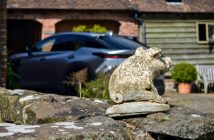The earth is coloured differently here. No more the greys of London or even the green expanses of my childhood Devon. The Cairngorms are cloaked in purple heather, forming an endless, undulating mass of deep mauve across the horizon, and before them the fields are alight with fiery orange gorse. Slicing through all this is the River Spey, a thick ribbon of freezing silvery water, which snakes down from the loch in Corrieyairack Forest and, after 107 miles, spills out into the Moray Firth.
Beautiful as the Speyside scenery is, the topography is special for reasons other than aesthetics: it’s an integral part of whisky production for which this region is renowned and by which it is sustained. Half of all Scotland’s distilleries lie along the glens of the Spey and its tributaries, taking the raw materials at their fingertips – barley, peat and mountain spring water – and alchemically distilling them into spirits that are coveted the world over.
It was in search of a fine dram that I boarded the Caledonian Sleeper train – depart from Euston at 21.15, wake up in Inverness at 08.30; that’s if you can doze off in the somewhat cramped, wobbling bunks: this is no Orient Express – and travelled to this corner of the Highlands, home to the world’s only Malt Whisky Trail.
Knockomie Hotel is perfectly poised for such an exploration, located on the frontier of the Trail in the historic market town of Forres, about 40 minutes east of Inverness. Built in 1914 in the Arts and Crafts style for a wealthy family of Indian tea plantation owners, today Knockomie is a boutique hotel of 15 individually decorated rooms. The hotel capitalises on the Scotch tourism niche with an impressive Malt Library that consists of more than 80 single malts and blends, along with an in-house expert running personalised tastings to help guide the uninitiated.
I must admit that until now I had experienced whisky only as something sinister diluted and disguised with Coca Cola, or as sips of a relative’s throat-scorching Islay dram, all peat and smoke. Despite his Scottish roots, my partner and fellow whisky pilgrim is similarly unenlightened. Yet, Speyside whiskies, I’m told at the hotel, are generally lighter, sweeter and more delicate than their smoky relatives in the Hebrides. As two whisky novices, both with a sweet tooth, we had, it seemed, chosen a good place to begin our education.
Our first port of call was Benromach, both the closest to the hotel and the region’s smallest working distillery. I was guided around the site – eerily quiet on a grey weekend in late February – by a genial Aberdonian named Sandy, who had worked in the whisky industry for 48 years. First, he sat us down to watch a short film on the company’s history (school field-trip memories sprang to mind at this point) which tells us about the distillery’s phoenix-like back story: founded in 1898, it ran into trouble in the 1980s and closed down for 15 years, until Gordon & MacPhail took over, set about an extensive renovation programme and had it reopened in 1998 by none other than Prince Charles.
Then it was on to where the magic happens. Inside the lofty main building we clambered along walkways between the gleaming copper vats and pipes. The pervasive smell was of warm yeast. Sandy lifted a lid on one of the fermenting pools and let me peer inside. The steaming mixture looked like simmering porridge. Clearly there was a long way to go until it got into the connoisseur’s cabinet.
Made from purely malted barley and spring water (if other types of grain are mixed in it becomes a ‘blended’ rather than single malt whisky), it’s amazing what variety of flavour and scent is achieved in different bottlings. At Benromach there are just two pairs of hands putting these two raw materials through a centuries-old distillation process consisting of four main stages: malting, brewing, distillation and maturation.
The first three of these steps are pretty standardised, soaking the grain to turn the starch into soluble sugars before a series of mashing, heating and finally drawing off the condensed spirit. It’s the final stage – in which the new-make whisky, at this point a clear liquid, is filled into oak casks and aged for anything between three and 60 years – that decides whether the malt will end up smoky or citrusy, pale and light or intense and peaty as it leeches flavour and colour from the wood. I learn that whisky is seldom stored in new casks as it takes on too much of the wood’s taste, which explains why in Benromach’s warehouse I spot old Bourbon barrels from America and others that once held sherry stamped with Spanish labels.




